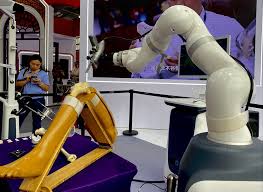The introduction of ROPA, likely short for Robotic Orthopedic Precision Assistant, marks a major breakthrough in orthopedic surgery. This advanced AI-powered surgical robot brings innovation to the field by addressing several common challenges in traditional orthopedic procedures.
One of the key features of ROPA is its ability to assist with preoperative planning. Instead of relying solely on a surgeon’s experience, ROPA uses detailed data analysis to create a personalized 3D model of the patient’s anatomy. Using CT scans, the robot provides surgeons with a highly accurate view of the surgical area, allowing them to plan the procedure with great precision.
This reduces the chances of subjective errors and ensures a more reliable approach to surgery.Another standout feature of ROPA is its visual and positional accuracy during surgery. Acting like a “digital eye,” the robot offers real-time monitoring and tracking of the patient’s anatomical structures.
This eliminates potential blind spots and helps the surgeon navigate complex areas with greater confidence and precision, improving overall accuracy and reducing the likelihood of errors.What truly sets ROPA apart is its unmatched precision and control. The robot can perform surgical movements with sub-millimeter accuracy, allowing for the careful application of force during procedures.
This level of precision minimizes the risk of human error, ensuring that each cut and placement is done exactly as planned. ROPA also positively impacts surgical outcomes by reducing some of the risks typically associated with traditional orthopedic surgeries. Patients may experience shorter recovery times and fewer postoperative complications, leading to a better overall experience.
ROPA’s debut at the China International Fair for Trade in Services (CIFTIS) highlights the growing role of AI and robotics in healthcare. These advancements are not only improving the quality of patient care but are also making surgeries safer and more efficient for both doctors and patients.
The development of such cutting-edge technology is a clear indication of the future direction of medical practice, where precision and safety are increasingly prioritized through the integration of robotics and AI.


